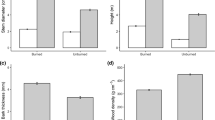Abstract
The performance (survival and growth) of Douglas-fir (Pseudotsuga menziesii Mirb. Franco.) seedlings planted in minimally disturbed, scalped, and bedded soils, both with and without herbicidal control of weeds, were compared. Douglas-fir growing for 3 years in bedded soils treated with herbicide were heavier, taller, and had deeper root systems than trees growing in other preparations. Scalping did not improve seedling performance when compared to minimally disturbed soils. Soils rich in organic matter benefited tree growth. Competing vegetation in raised beds was detrimental to seedling performance.
Similar content being viewed by others
References
Beebe, R. 1982. Are handscalps an effective method of site preparation in central Washington? pp. 45–48. In: Baumgartner, D. (Ed) Proceedings, Site Preparation and Fuels Management on Steep Terrain. Spokane, Washington. Washington State Univ., Pullman.
Blake, G. R. and Hartge, K. H. 1986. Bulk density, pp. 363–376. In: Klute, A. (Ed) Methods of Soil Analysis Part One-Physical and Mineralogical Methods. Agronomy monograph No. 9, 2nd. ed. Amer. Soc. Agr. Madison, Wisconsin.
Bremner, J. M. and Mulvaney, C. S. 1982. Nitrogen-Total. In: Page, A. L. (Ed) Methods of Soil Analysis. Part 2, Agronomy. Am. Soc. of Agron., Madison, WI. 9: 595–624.
Finklin, A. I. 1983. Climate of Priest River Experimental Forest, Northern Idaho. USDA. Forest Serv., Intermountain Res. Sta., Ogden, Utah. Gen. Tech. Rep. INT-159.53 p.
Frederick, D. J., Madgwick, H. A. I., Jurgensen, M. F. and Oliver, G. R. 1985. Dry matter production and nutrient content of 5-year-old Eucalyptus nitens growing on soil mounds in New Zealand, pp. 589–596. In: Grey, C. D., Schonau, A. P. G., Shutz, C. J., van Laar, A. (Eds) Symposium on Site and Productivity of Fast Growing Plantations. Vol. 2 of Untitled Volumes. Rotorua, New Zealand: International Union of Forestry Research Organizations.
Froehlich, H. A. 1974. Soil compaction: implications for young-growth management, pp. 49–64. In: Berg, A. B. (Ed) Managing Young Forests in the Douglas-fir Region Vol 4, School of Forestry. Oregon State Univ. Corvallis.
Gilmore, A. R., Geyer, W. A. and Boggess, W. R. 1968. Microsite and height growth of yellow poplar. For. Sci. 14(4):420–426.
Goldin, A. 1987. Reassessing of use of loss-on-ignition for estimating organic matter content in noncalcareous soils. Comm. Soil Sci. Plant Anal. 18: 111–116.
Gutzwiler, J. R. 1976. Mechanical site preparation for tree planting in the Inland Northwest, pp. 117–132. In: Baumgartner, D. and Boyd, R. (Eds) Proceedings, Tree planting in the Inland Northwest. Washington State Univ. Pullman.
Harvey, A. E., Jurgensen, M. F., Larsen, M. J. and Graham, R. T. 1986. Decaying organic material and soil quality in the Inland Northwest: A management opportunity. USDA Forest Serv., Intermountain Res. Sta., Ogden, Utah. Gen. Tech. Rep. INT-225.15 p.
Keeney, D. R. and Nelson, D. W. 1982. Nitrogen-Inorganic Forms. In: Page, A. L. (Ed) Methods of Soil Analysis. Part 2, Agronomy. AM. Soc. of Agron., Madison, WI. 9: 643–698.
Mize, C. W. and Schultz, R. C. 1985. Comparing treatment means correctly and appropriately. Can. J. For. Res. 16: 1142–1148.
McKee, W. H., Jr. and Shoulders, E. 1974. Slash pine biomass response to site preparation soil properties. Proc. Soil Sci. Soc. of Amer. 38: 144–148.
McMinn, J. W. 1969. Preparing sites for pine plantings in southern Florida. USDA Forest Serv., Southeastern Exp. Sta., Asheville, North Carolina. Res. Note. SE-117. 5 p.
Place, I. C. M. 1950. Comparative moisture regimes of humus and rotten wood. Canada Department of Resources and Development, Forestry Branch, Ottawa, Ontario, Canada. Silv. Leaf 37. 2 p.
Schultz, R. P. and Wilhite, L. P. 1974. Changes in a flatwood site following intensive preparation. For. Sci. 20: 230–237.
Sloan, J. P. and Ryker, R. A. 1986. Large scalps improve survival and growth of planted conifers in central Idaho. USDA Forest Serv., Intermountain Res. Sta., Ogden, Utah. Res. Pap. INT-366.9 p.
Steele, R. D. and Torrie, J. H. 1960. Principles and procedures of statistics. McGraw-Hill Co., New York. 481 p.
Author information
Authors and Affiliations
Rights and permissions
About this article
Cite this article
Graham, R.T., Harvey, A.E. & Jurgensen, M.F. Effect of site preparation on survival and growth of Douglas-fir (Pseudotsuga menziessi Mirb. Franco.) seedlings. New Forest 3, 89–98 (1989). https://doi.org/10.1007/BF00128903
Received:
Accepted:
Issue Date:
DOI: https://doi.org/10.1007/BF00128903




